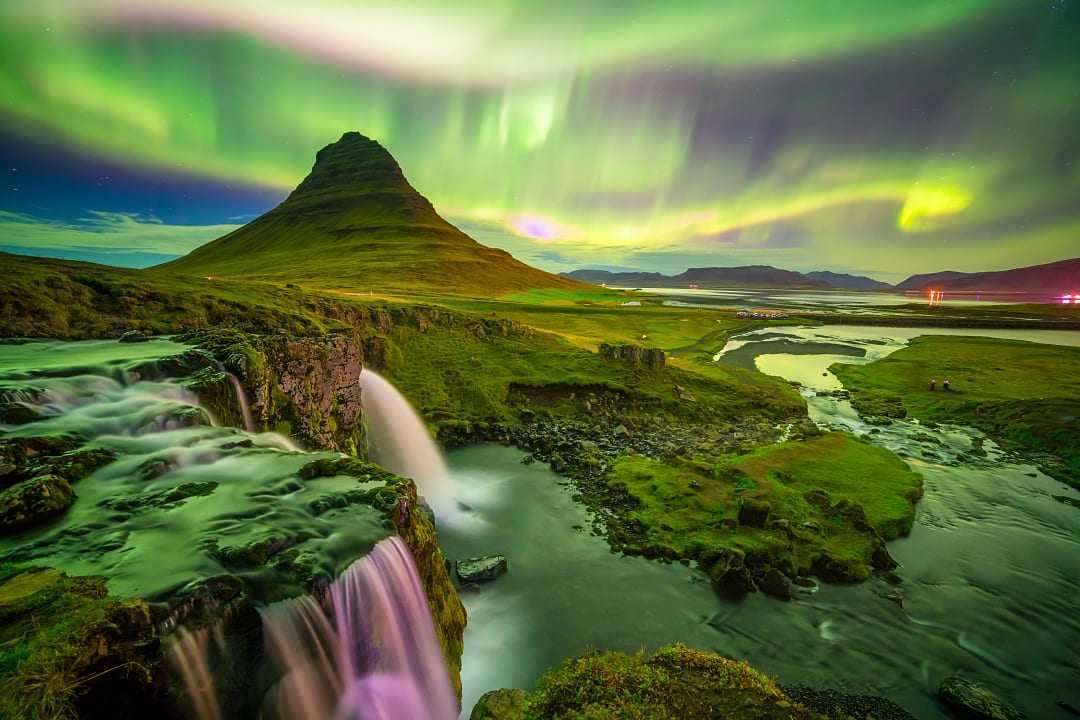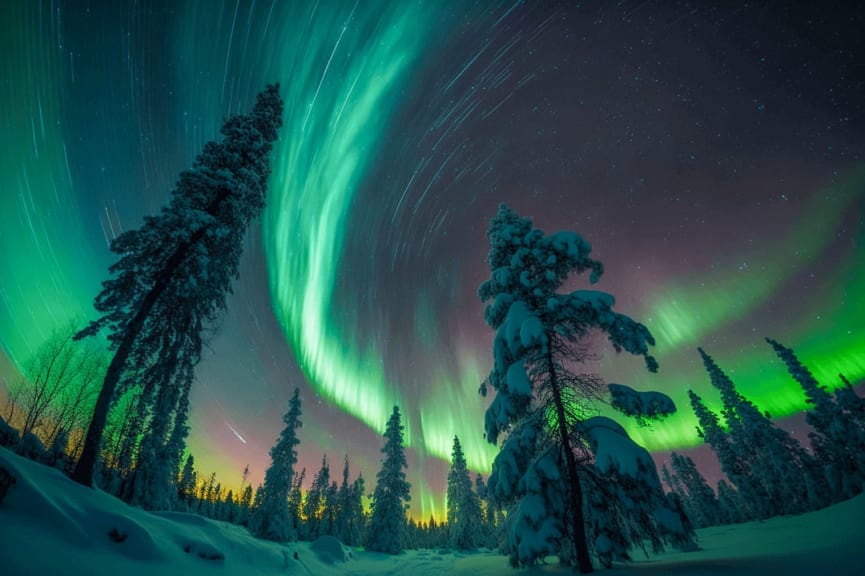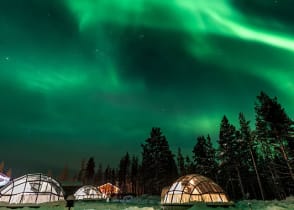Best Places to See the Northern Lights: What They Are, How to See Them, Where to Go, & More

Mount Kirkjufell near Reykjavik, Iceland
The Northern Lights are an impressive display of color and natural beauty, and this article provides information on where to see them, what they are, and more.
The lights create a mesmerizing dance across the night skies that is best seen between September and March in countries like Iceland, Norway, Sweden, and Finland.
Imagine snuggling up under a blanket, hot chocolate in hand, a bonfire close by perhaps, to view nature at spectacular play.
What Are the Northern Lights

Finnish Lapland, Finland. Photo courtesy of Visit Finland
The aurora borealis, with its shifting waves of green, purple, red, and blue, has captivated people for centuries. These Northern Lights are the result of electrically charged particles from solar winds colliding with gasses in the Earth’s upper atmosphere.
The aurora most often forms in regions concentrated around the north and south poles, where solar wind particles are funneled in by Earth's magnetic field. When these collide with atmospheric gasses like oxygen, nitrogen, and neon, the gasses light up.
The colors depend on which gas is colliding with the particles. Oxygen typically produces yellowish-green or green lights, while nitrogen triggers blue and violet hues, and neon creates red aurora. The shifting shapes correspond with activity from the solar winds and storms.
Best Time to See the Northern Lights

Hamnoy, Norway
The best time to see the Northern Lights is during the Northern Hemisphere’s winter, from September through early April, when the nights are longer, the skies clearer, and there is increased solar activity.
The equinoxes in September-October and February-March tend to result in frequent and vivid displays, while solar activity also impacts the intensity of the lights.
In peak season, your best sighting opportunities happen between dusk and dawn, when skies are at their darkest. Taking an evening Northern Lights cruise or heading to remote, high-latitude locations away from light pollution can set you up for the magical celestial show, which can go on until the wee morning hours.
How to See the Northern Lights

Finnish Lapland, Finland
Catching the dazzling Northern Lights requires planning and luck. Start by heading as far north as possible, travel between September and March for extended dark hours, and keep an eye on space weather forecasts and visibility reports. The clearer the skies and the stronger the solar flares and geomagnetic storms, the more likely the magical lights will shine. Get away from city lights for true darkness in rural locales.
Having patience and allowing your eyes to fully adjust to the darkness will aid immensely in spotting and enjoying nature’s endless dance. To best photograph the lights, use manual camera settings with long exposure and high ISO, while experimenting with lenses and vantage points for your desired perspective on the otherworldly event.
Where to See the Northern Lights

Tromsø, Norway
Reykjavik, Iceland
In Iceland, the capital, Reykjavik, is considered one of the best places from which to see the Northern Lights. Within its reach, Thingvellir National Park offers an exceptional vantage point because of its proximity to the Arctic Circle and lowered light pollution due to its preservation status. Other ideal viewing locations in the Reykjavik realm include Aurora Reykjavik and Aurora Village, as well as the Reykjanes Peninsula.
Tromsø, Norway
If you are traveling to Norway, then head for Tromsø to catch the spectacle dancing across the frigid night sky. Its location deep in the Aurora Zone within the Arctic Circle renders frequent spectacular light shows in the dark winter months, which you can view from parks, lakes, bridges, and bays that face directly north. Other Norwegian cities considered ideal for chasing the lights include Alta, Namsos, Svalbard, and remote northern towns and villages above the Arctic Circle.
Swedish Lapland, Sweden
In Sweden, Swedish Lapland in the Auroral Oval in the Arctic Circle is where you should head to witness the dazzling spectacle. This remote area, home of the indigenous Sami people, provides large swaths of unspoiled wilderness, with little light pollution or people, allowing the celestial light spectacle to take center stage. Top observation locations include Abisko National Park, the Lannavaara viewing platform, and a slew of small northern towns and villages that face directly north.
Finnish Lapland, Finland
Finnish Lapland in Finland offers stunning views of the Northern Lights as it sits directly beneath the Auroral Oval in the Arctic Circle. The Lapland towns of Muonio, Ylläs, Rovaniemi, and Kakslauttanen provide front-row seats for the magical show, with ample northern-facing viewing spots devoid of light pollution. Some resorts in the region feature igloo and glass accommodations designed specifically for Northern Lights viewing.
Why 2024 and 2025 Are Good Years to See the Northern Lights

Swedish Lappland, Sweden
This year and next will provide you with the best opportunity to view the Northern Lights in more than a decade because the sun is experiencing a Solar Maximum.
A Solar Maximum refers to a period of greatest solar activity in the approximately 11-year solar cycle of the sun. The last event took place in 2014.
During a Solar Maximum, the sun's magnetic field lines are the most distorted due to the magnetic field on the solar equator rotating at a slightly faster pace than at the solar poles. This causes energy releases in the form of solar flares and coronal mass ejections, resulting in more sunspots on the solar surface and more intense solar radiation.
Plan Your Trip to See the Northern Lights

Jokulsarlon Glacier Lagoon in Iceland
Preparing for the splendor of seeing the elusive Northern Lights requires careful planning and perfect timing. As this celestial phenomenon only occurs under specific conditions, attempting to see it demands research for optimal visibility, which is where Zicasso comes in. While a glimpse of Mother Nature’s spectacle is never guaranteed, properly preparing your Aurora Borealis expedition helps to increase the odds.
For more travel inspiration, see our trips of a lifetime to discover what more the world has to offer.
Life-Enriching Travel Designed Just for You
- 1
Trips curated by the world’s top destination experts
- 2
Concierge-level service leading up to and during your trip
- 3
Unique, exclusive experiences and insider access





